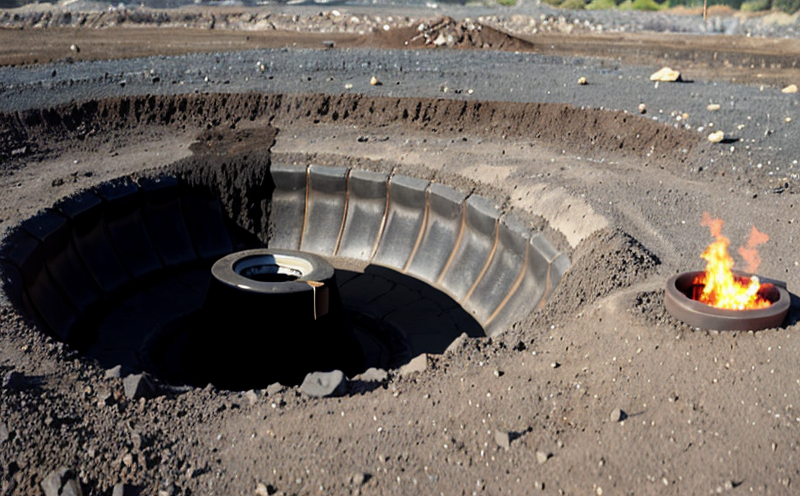JIS M8817 Trace Elements in Coal Testing
The Japanese Industrial Standard (JIS) M8817 is a method specifically designed to determine the trace elements present in coal. This test is crucial for ensuring compliance with international and domestic regulations, as well as for quality assurance purposes within the mining sector.
Trace elements play a significant role in the overall composition of coal, influencing its properties such as calorific value, ash content, and environmental impact during combustion processes. Understanding these trace elements is vital for industries that rely on coal as a primary energy source or raw material. The test outlined in JIS M8817 provides a reliable means to assess the presence and concentration levels of these elements.
The standard specifies detailed procedures for sample preparation, including drying, crushing, and sieving techniques aimed at achieving homogeneity within the coal sample. Once prepared, the samples are then subjected to various analytical methods, such as inductively coupled plasma optical emission spectrometry (ICP-OES), which allows for precise quantification of trace elements.
The acceptance criteria defined by JIS M8817 ensure that results meet specified limits set forth by regulatory bodies. Compliance with these standards is essential for maintaining product quality and ensuring safety across all stages of coal utilization, from mining operations to end-user applications.
For R&D engineers involved in developing new technologies related to coal processing or combustion efficiency improvements, understanding trace element concentrations through JIS M8817 can lead to breakthroughs in optimizing processes. Similarly, quality managers and compliance officers responsible for monitoring adherence to environmental regulations will find this test indispensable.
Trace elements like arsenic (As), mercury (Hg), selenium (Se), and others may have toxicological implications if not controlled properly during mining or use phases. Therefore, accurate determination using JIS M8817 helps mitigate potential risks associated with these substances.
In summary, JIS M8817 provides a robust framework for evaluating trace elements in coal samples, which is critical for maintaining high standards of safety and performance across industries reliant on this resource. By adhering to these methods, stakeholders can ensure they are meeting regulatory requirements while also contributing positively towards sustainability goals.
Why It Matters
The significance of JIS M8817 trace element testing extends beyond mere compliance; it plays a pivotal role in safeguarding both human health and environmental integrity. Trace elements, though present in minute quantities within coal, can accumulate over time when released into the atmosphere through combustion processes.
For instance, high levels of mercury or arsenic could pose serious threats to ecosystems and living organisms if not managed effectively. Regulatory bodies around the world recognize this risk and have implemented stringent standards like JIS M8817 to regulate their concentrations in coal products.
In addition to environmental concerns, trace elements also affect the technical performance of coal-based fuels and materials. For example, sulfur compounds contribute significantly to acid rain formation when released during combustion; thus, accurate measurement ensures better management practices that minimize adverse effects.
Moreover, understanding the composition of trace elements helps optimize extraction methods at mines by identifying valuable minerals embedded within coal seams. This knowledge supports more efficient resource utilization and reduces waste generation.
The importance of JIS M8817 cannot be overstated in today's era where sustainability and responsible stewardship are paramount considerations across various sectors, including mining and energy production.
Industry Applications
JIS M8817 trace element testing finds extensive application throughout the coal lifecycle, from mine extraction to end-user consumption. In mining operations, this test serves as an essential quality control tool ensuring that raw coal meets specified purity levels before processing.
During preprocessing stages at power plants or industrial facilities utilizing coal, accurate determination of trace elements aids in optimizing combustion efficiency and reducing emissions. This translates directly into cost savings for operators by minimizing fuel waste while simultaneously lowering operational costs associated with pollution control measures.
For environmental monitoring agencies tasked with assessing the impact of coal usage on air quality and water resources, JIS M8817 provides valuable data points necessary for informed decision-making regarding mitigation strategies. Additionally, this information assists researchers studying long-term effects of trace element accumulation in soil and aquatic environments.
Ultimately, compliance with standards like JIS M8817 fosters trust between stakeholders, enhances reputation through transparent reporting practices, and promotes best industry practices that benefit all parties involved in the coal value chain.
Why Choose This Test
Choosing JIS M8817 for trace element analysis offers numerous advantages over other testing methods available on the market. Firstly, it adheres strictly to internationally recognized guidelines ensuring consistent and accurate results regardless of location or lab performing the tests.
The precision offered by this standard makes it particularly attractive for research institutions conducting cutting-edge studies involving coal chemistry. Furthermore, compliance with JIS M8817 can help organizations avoid legal complications arising from non-compliance with local regulations.
From an operational perspective, implementing JIS M8817 facilitates smoother supply chains by providing clear specifications that all participants must adhere to. This harmonization reduces variability in product quality while enhancing overall efficiency within the industry.
In conclusion, selecting JIS M8817 for trace element testing not only meets regulatory requirements but also sets a benchmark for excellence in coal analysis, contributing significantly to safer practices and sustainable development goals.





